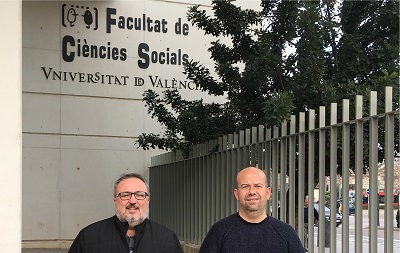Three researchers from the Faculty of Social Sciences of the Universitat de València have described the link between the drug use and the growth of the juvenile delinquency, so cannabis is linked to initial criminal trajectories and cocaine is related to consolidated criminal activity. The research, based on a sample of 286 teenagers from the Judicial Orders Program of the Valencian government, highlights the proportional link between a greater abuse and dependence and a greater possibility of committing offenses.

Francesc Xavier Uceda Maza, José Javier Navarro Pérez and José Vicente Pérez Cosín use the term Teenagers in conflict with the law, hereinafter ACL, to designate young people between 14 and 18 years with criminal trajectories of different degree and whose project of socialisation has been affected by drugs. This use takes place during the day on a regular basis and it is linked to leisure at night.
According to the data provided by the three researchers in the article Teenagers and drugs: their relation with delinquency published in Revista de Estudios Sociales, 35.5% of the ACL consumes cannabis, 13.6% alcohol and in a similar percentage cocaine and cannabis with 13.6% of them. These results show the 38% of the ACL who have consumed, among which 26% consumes on a regular basis and 12% is addicted.
The professors of the Faculty of Social Sciences and researchers from the Inter-university Institute for Local Development who are attached to the Department of Social Work and Social Services, establish three groups regarding the criminal trajectory in relation to drug use: initial, moderate and consolidated. Within the group of teenagers with an initial trajectory, the regular drug use is set at 17.2%, the dependence is set at 0.8% and the sporadic use is set at 1%.
Regarding the moderate criminal trajectory, 38.1% of the teenagers take drugs and within this group the sporadic use represents 0.4%, 30.5% usually takes drugs and 6.8% of the teenagers in conflict with the law of this group. As for the type of substance, cannabis represents 20.7% and cocaine 9.3%. Regarding the ACL with a consolidated trajectory, 70.5% takes drugs. The type of use is equally divided between the sporadic, the regular and the dependence with 23.5% each of them.
These are the conclusions obtained after a data collection which took place in Valencia in 2013. 422 judicial orders related to 286 teenagers in conflict with the law were taken into account. From each record, it has been extracted indicators of use, non-use and abuse, type of substance and form of consumption from a quantitative perspective. Afterwards, a classification of sporadic, regular and dependence use has been made.
This information forms a sample of 172 typologies of criminal actions in relation to several factors. Some variables such as the amount of crimes committed of whatever nature, the number of months of the measures imposed and the number of measures executed or pending to execute have been analysed. Therefore, the result is a global variable which the better the value, the longer criminal trajectory of the teenager.
Francesc Xavier Uceda Maza, José Javier Navarro Pérez and José Vicente Pérez Cosín conclude that “the establishment of strong bon with drugs in the preadolescence predicts future strong risk manifestations. Nowadays, the use of narcotics do not correspond to marginal group patterns, but it can be found in people with acceptable levels of integration.”
Furthermore, “in many cases the teenager lacks of a mature reflection and he can be pushed into drug abuse. Drug itself no not constitute a risk, but the maturity and the capacity of confrontation to regulate the consumption of the teenager should be taken into account. It can be proved that the change in the criminal profiles responds to changes in the types and practices of the drug use,” highlights José Vicente Pérez, professor of the Department of Social Work and Social Services of the UV.
Another conclusion of the article is that the usual cause which generates the crime among the first stages of the criminal trajectory is the wish of the teenagers of achieving the promotion of the group in order to be socially accepted. Regarding the preventive effects, the researchers highlights the importance of keeping the support and a full emotional life because the familiar support is considered to be crucial against the drug use. When the ACL reaches the early adolescence, la supervision is of the utmost importance and the lack of it can originate manifestations in which the drugs are linked to anti-social behaviours.
Article:
Francesc Xavier Uceda-Maza, José-Javier Navarro-Pérez, José Vicente Pérez-Cosín: Teenagers and drugs: their relation with delinquency Revista de Estudios Sociales, October-December 2016 (63-75)
http://dx.doi.org/10.7440/res58.2016.05

.jpg)







